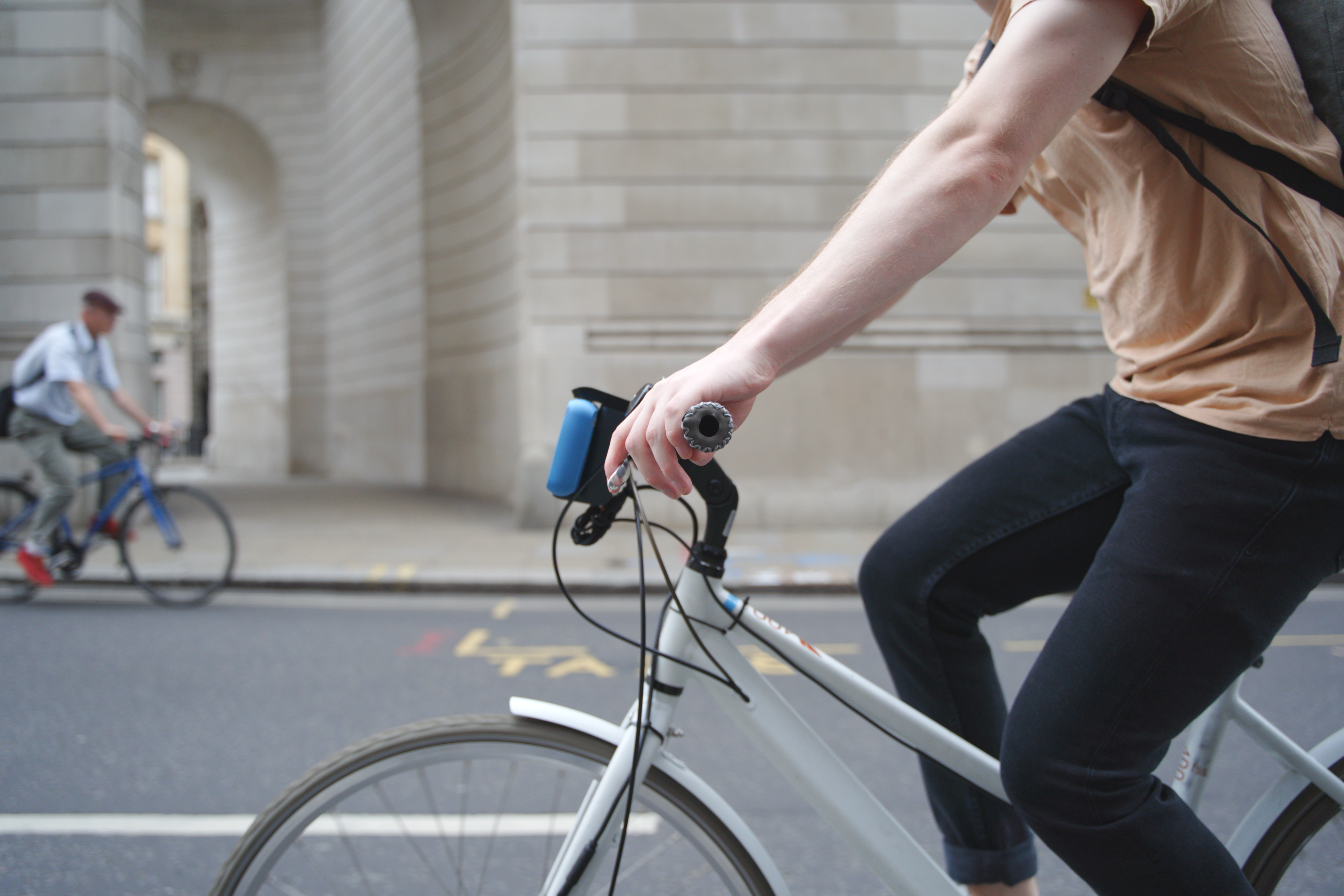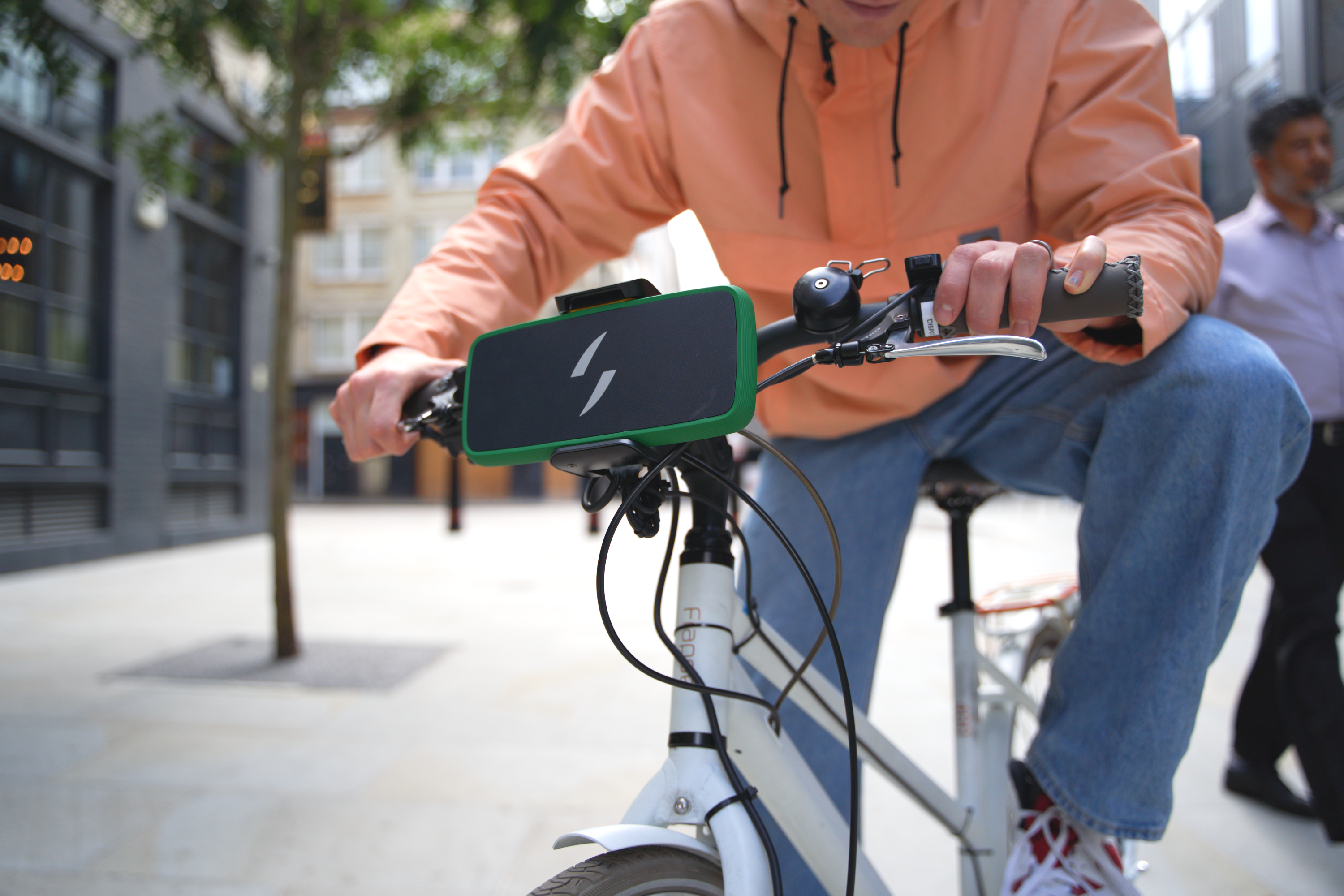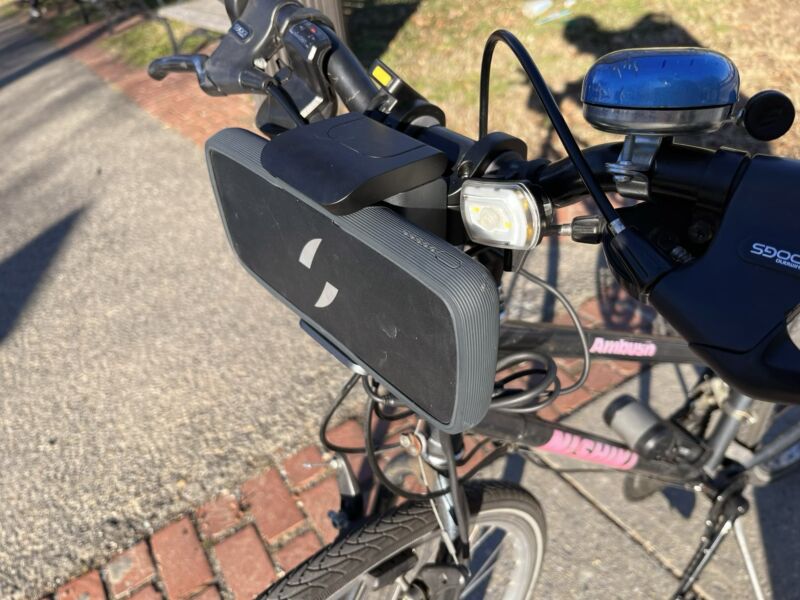What it’s like buying, installing, and riding an e-bike upgrade.

Recommending the Swytch e-bike conversion kit feels like recommending a DIY desktop computer upgrade. You’re not evaluating or describing any one experience so much as telling somebody that it might save them money, that it could be a fun project, and that the end result can be a point of pride. Though it would be easier, you can’t replicate the upgrade experience by simply buying another bike. It all depends on what you want out of an e-bike—or a weekend project.
I’ve now converted two bikes with Swytch kits, I’ve walked my in-laws through upgrading their own cruiser-style bikes with them, and I’ve made tweaks and fixes to all of the bikes over two years. What I’ve learned is that there’s no single “Swytch kit experience” because every bike is a collection of components, and each component has dimensions and angles and quirks that play off the kit in different ways.
Some people will drop the front wheel off their bike, replace it with Swytch’s wheel, strap down a few cables with zip-ties, mount a battery, and feel the boost on their first ride a couple hours later. Some people will learn a lot more about rims, tires, and beads than they knew before or discover that their seemingly normal-looking front fork is quirky and find that the dropouts require some filing.
If you’re willing to dig into your bike just a bit, or you’ve got someone on the hook ready to do that for you, the Swytch kit is a good option to help with commutes, hills, or casual rides. It’s less helpful if you’re looking for gobs of power, prefer to own a complete second bike, or want lots of range. Small things can go wrong, and the support is far from perfect. But the end result is typically a fun upgrade and a great introduction to e-bike life.
Buying a Swytch kit: The first DIY experience

With most e-bikes, even the kind shipped directly to your house, there are only a few choices when ordering: color, frame size (typically based on height), maybe your battery size and range, and accessories.Advertisement
When you’re ordering a Swytch, you have to know (or learn) a bit more about your bike. You need your wheel size, for instance, because Swytch offers kits for 29er, 28-inch (or 700c), 26-inch, 20-inch, and Brompton-sized 16-inch tires. You pick out a wheel color (black or silver) and decide if you want an optional throttle or just pedal assist.
The big choice is between batteries: the 90 Wh, 15 kilometer (9.3 mile) Air model or the 180 Wh, 30 km (18.6-mile), can’t-take-it-on-a-plane Max version. And you have to confirm a few things about your bike, including whether you have disc or rim brakes and the width of your fork dropouts. The process has improved since my experience—you now start off by telling Swytch your bike model, or by taking a photo, and then get back a compatibility report.
The next issue is the timing. You typically can’t buy a Swytch kit from standing inventory and have it shipped within a few days. Swytch batches preorders together and ships them in broad timeframes, like “Fall 2024.” After you sign up for their waitlist, you’ll receive notice when you can order. Swytch previously told me that this helped keep prices lower and allowed the company to offer a wider array of kits and options to customers. This is likely true, but it means you have to delay your e-bike project enthusiasm by a few weeks—or maybe months.
You’ll also need to consider all the accessories you’ll want for your Swytch up front. Swytch doesn’t make it easy to buy spare chargers, batteries, or alternative battery mounts. There’s a web market for certain countries, including the U.S., but it doesn’t offer everything. Your best bet is to add them onto your initial order in the order portal, which you can only access once you’ve been tapped for a pre-order, or to contact support (more on that later).
The price of a Swytch kit depends on your range choice, wheel size, and accessories, but they generally run between $550 and $1,200, or even $1,500 with no pre-order sale. There’s an upcoming stripped-back version, frame-hung version, the Swytch Go, that’s available for pre-order and purports to start at $400.
ARS VIDEO
How The Callisto Protocol’s Team Designed Its Terrifying, Immersive Audio
- First you install the front wheel, which has the 250 W motor. Kevin Purdy
- Then you install the ring with the metal dots around your non-drive-side crank, along with the sensor that monitors it. Kevin Purdy
- Top view of the cadence sensor and ring. Kevin Purdy
- You make room on your handlebar for the battery display. This model of display has seemingly been displaced by a newer version. Also, LCD displays sometimes refuse to work with photo capture; this display did actually work. Kevin Purdy
- You install the battery clamp on the center of your handlebars, around the stem, you zip-tie everything into place, and then you ride! (Or find out what you did wrong.) You also have the option of rear seat post and downtube bottle cage mounting. Kevin Purdy
Building a Swytch bike: The “it depends” part
I have an older version of the Swytch kit, the one with a battery that looks like a handlebar bag, on my own bike. I’ve set up the newest (and now only) version of the kit, with the Air battery, on both my bike and my wife’s bike. I’ve likely ridden more than 400 miles with Swytch kits since I installed that first one in late January 2022. The wheels, motors, and pedal sensors are largely the same between generations, but the current Swytch models have batteries that are easier to attach, remove, and take with you, plus a separate handlebar display instead of on-battery controls. The installation is quite similar.
The two Swytch kits I’ve installed have both come to me as a reviewer. Each one had a notable mechanical quibble that had to be worked out with Swytch’s support staff. Each time, the staff was very friendly and knew exactly what the issue was. I can’t promise that will be every customer’s experience, of course. My in-laws purchased Swytch kits for their hybrid bikes (without Swytch knowing our relation), hired a local bike shop to install their kits, and that shop reported no problems at all.
On my 2018 Norco, Swytch’s techs didn’t quite trust the measurement I gave them for the fork dropouts. Swytch arranged for a video call, and a very helpful engineer taught me a few things about using the digital calipers with which I’d botched the last measurement. On my wife’s mid-’90s Nishiki hybrid, the issue was that puncture-resistant Marathon Plus tires didn’t always seat well into the standard Swytch rim width, especially at narrower widths. Swytch sent a replacement wheel on which the tire seated better.Advertisement
Swytch’s explainer and basic fitting guide.
If you get the right parts and nothing is wrong before you start, the first Swytch project is removing your front wheel and, presuming you don’t have a spare tube and tire, removing those from the old front wheel. If you have disc brakes, you have to transfer that disc, too (or sometimes replace it, depending on the size). You slot the wheel into your 9 mm or 10 mm dropouts, fit some washers on either side, and, if you have rim brakes, adjust those to ensure they contact the new rim properly. If your bike has a steel frame, you can likely get by without additional torque control measures; some owners of aluminum and carbon forks should install some additional (included) gear.
That previous paragraph is the most technical, bike-knowledge-specific part of most Swytch installations—tires, tubes, brakes, and wheels—so it should give you a sense of how you’ll do or who you can ask for help. From there, the work can be a bit fiddly, but it’s not specialized. The remaining steps are (for every bike except the Brompton):
- Fit a disc with little magnetic dots on it around a crank axle (opposite your front gear/chainring) and onto a crank
- Stick a pedal sensor onto your frame’s down tube, such that it catches the rotations of those little dots
- Attach a battery mount to your handlebars using hex screws and brackets
- Similarly clamp the power/battery display to your handlebars (or, more recently, to the back of your seat post or your down tube bottle cage)
- Connect and tidy up the wires between the battery, display, and motor using zip ties, velcro, or whatever you have handy
- Mess with the display console settings a bit to set your wheel size, adjust speed caps, and set other preferences.
There’s room for things to get more complicated within each of those bullet points, depending on the shape and space available on your handlebars, the space between your cranks and frame, and other factors. Generally, though, after following the instructions and reading every helpful hint (especially about leaving enough wire slack to turn your handlebars), I think most people who are keen enough on biking to want a DIY e-bike can install the Swytch kit.Advertisement

Owning a Swytch bike: A power/practicality balance
Unlike most e-bike reviews, I can’t tell you how your Swytch-augmented bike will ride, because it’s your bike. The tires, brakes, geometry, handling, suspension, road feel—everything will be the same as the bike you had. Your bike will have a few extra pounds on it, especially toward the front, even when the battery isn’t on the bike. But everything you like and dislike about how your bike rides remains the same.
The numbers on the Swytch kit—250 W motor, 36 V battery, 9 or 18 miles of range—should give you the sense that this is not a kit meant for mountain biking, cargo hauling, food delivery, or aerodynamic-minded, Strava-tracked rides. For commutes, errands, and casual rides, however, the Swytch offers some unique benefits.
For one thing, depending on how well the Swytch wheel matches the rest of your bike (you have rim and spoke options in black and silver), your regular bike will likely still look like a regular bike to most people. After you remove the battery, there’s a clamp (could be a luggage/bag thing), a tiny LCD display (lots of those on bikes), and a black plastic thing inside one crank (maybe it’s a distance counter). It reduces your bike’s attraction to thieves and might even help you avoid having to deal with policies banning e-bikes from certain indoor spaces (not that you’d ever try to skirt those).
The other major benefit is that your Swytch bike can fall back to being a regular bike, one that’s familiar. There’s no handling or gearing to re-learn. The handlebars and tires feel just like you expect them to. If you don’t feel like having an assist on a ride, you can just take off the battery and your bike is still your bike—though maybe 2 pounds heavier because of the wheel motor.

Riding a Swytch bike: The ghost foot experience
The Swytch’s motor is primarily meant to be driven by the cadence sensor you attach to your frame, and that watches the disc around your bottom bracket cycle past. There’s an optional throttle, but there’s not enough power to really launch most people from a dead stop. It takes maybe 15-20 degrees of crank/pedal rotation before the motor gets spinning, and it tends to rev up rather than rocket forward.
In practice, this means having to think a bit about what gear you want to be in when you get stuck in traffic or on a trail. If the bike you convert has a decent range of gears, this shouldn’t be too hard. If you’re hoping the Swytch can make an impractical bike practical, however, I wouldn’t recommend that investment. Swytch kits are more useful for boosting, improving, and extending, not for transforming. You will still be pedaling a Swytch bike, and it will resemble regular bike riding. It will in no way remind you of an electric moped unless you get the throttle and open it up on long, empty stretches.
Once you’ve moved on from a dead start, the Swytch gets its chance to shine. There are five levels of assistance. Even at level one, you’ll notice that hills feel less like hills and that each stroke tends to give you a bit more coasting distance. At level three, you’ll regularly feel that quirky state of e-bike riding where you’re merely spinning the pedals to keep the bike moving, unless you head into your highest gears. I’ve only used levels four and five on dire hills and experiments on long, empty stretches; I’d almost always rather save the battery power for longevity. For most people, levels one through three should be fine for making their pedaling count for more distance.Advertisement
The Swytch pedal-assist experience is like having pedals that are big enough for both your feet, plus the feet of a paternalistic, enthusiastic, and invisible second rider. This rider wants you to feel like you’re the one taking the bike ride, but they’ll still help when they notice you slowing down on a hill, when your knees are hurting, or when you want to get going a bit faster from a stop. This invisible pedal pusher believes in safe riding, so they’ll stop pedaling the moment you reach a fast-enough 20 mph (or just over 15 mph in much of Europe), hoping you get the message. They’re not wearing Lycra, and they’re not a bike messenger; they’re just eager to see you get more miles.
Swytch’s kit can make loaded-down panniers feel less heavy, help you keep up with faster friends or relatives on a group ride, or be ready for when you can’t avoid some spirit-breaking hills. You’ll still need to provide some power, but not too much. And with the current Air model, it takes just a few seconds to remove a battery that can be easily stored in a purse, backpack, or even a winter coat pocket. It’s not a new mode of transportation; it’s a friend you bring with you on rides.

Getting the Swytch bike just right: The trickiest part
Most Swytch owners will one day reach a point where they’re no longer thinking about the kit itself. I’m mostly at that point with the two Swytch kits in my home, and my in-laws are there with their own professionally installed Swytch systems. It’s just riding a regular bike with a boost and charging the battery every ride or two.Advertisement
But most people will also have to work out the kinks of their retrofit e-bike, and that will require more thinking than with brand-new e-bikes. In my time riding and assisting with Swytch builds, I’ve dealt with:
- Cadence sensors that need further adjustment and securing
- Arranging handlebar cables so that they can’t get caught in the battery clamp when it’s empty
- Finding and keeping a small adjustable wrench in my saddle bag, because Swytch wheels are bolt-tightened rather than quick-release
- Adjusting my shifting style on my belt-driven, internal-geared bike due to some interplay with a powered ride
- Occasional vibration from the motor, usually attributable to bad input from the cadence sensor or throttle
- Making space on a handlebar to strap on a front light, since the battery and display now take up space
None of these things have been defeating, and most of them are simple fixes once you suss out the real issue. What’s more, every e-bike I’ve tested that has been shipped directly to me often requires a good number of tweaks, plus some basic assembly. But it’s worth factoring the time cost of getting a Swytch kit working just right into the overall cost of the kit when shopping it against a second e-bike.

Support for the Swytch kit
As noted, most of my support has been through Swytch’s press team, but my in-laws made no mention of me in their Swytch dealings.
My father-in-law had trouble with a (first-generation) battery that was randomly shutting down, requiring a tricky reset procedure to bring it back each time. “I would ask one representative one question and he would give me something to do, and the next time I responded I would be dealing with another service person. Sometimes it didn’t seem like they read the responses I wrote previously,” he told me. After, in his words, “lots of communication and advocacy” to convince Swytch that his issue wasn’t a matter of improperly storing or charging the battery, Swytch did eventually send him a replacement.
That’s not an ideal experience. In inquiring about buying a second charger for my wife’s bike at work (from outside my press email), I, too, encountered a bit of back-and-forth with a few different support staffers, though it eventually ended with Swytch shipping me a free conversion dongle. Most riders, hopefully, should get to spend far more time riding than dealing with an email support ticket.
Search Reddit or e-bike forums, and you’ll find complaints about kit malfunctions and delayed Swytch support. People don’t tend to write posts about products they bought that presented no problems, of course, or support tickets that went just great. What’s more, it’s always going to be difficult to diagnose, describe, and immediately fix an issue with an e-bike kit installed on one of literally thousands of different models of bikes. Those looking for more hands-on support and return assurance should likely purchase a dedicated e-bike through a local dealer.
Do we recommend the Swytch kit? Yes, if you know what it is
For the price of a shipped Swytch kit, you can potentially find a more powerful e-bike motor—perhaps a rear hub or a mid-drive model. You might also find a far larger, non-fire-hazard battery from a reliable vendor. If you’re very handy, you can probably even patch together the motor, battery, battery management system (BMS), display, sensors (or throttles), and the wiring yourself, possibly still under or close to the price. I’ve been seeing this boast in Reddit and on forum threads ever since I first looked into Swytch kits.Advertisement
It’s true, but the world of truly DIY e-bike building is bewildering. You’ll have to spend a lot of time, or undertake a few experiments, before you arrive at trusted vendors, a good understanding of parts compatibility, and assurance that your bike can handle modern e-bike parts. You’ll want to put a lot of time into researching a DIY e-bike before you charge it anywhere near your home.
What Swytch offers is really an e-bike beginner’s kit. It’s a set of lower-powered but tested components with wide compatibility, backed by a company you can reach for support, with some clever work done to make the battery easy to connect, remove, and charge. Having installed a different beginner-minded e-bike kit on my wife’s bike, I can confirm that ease of battery removal is no small thing. Lining up the pins on a screw-on barrel connector doesn’t seem like too much work… until you have to do it every time you park and ride the bike.
I don’t take my Swytch battery along on every ride, but it’s my grocery-hauling assistant, summertime sweat reducer, and secret weapon when my riding group wants to do 30 miles on a weekday night, ending at a point a few miles from my home. And I feel far less concerned about theft when locking up my battery-less bike outside a grocery store, with a standard U-lock, than I would if I owned most fully fledged e-bikes.
A Swytch bike isn’t the easiest e-bike to review. With some work, though, it has been a handy little e-bike to fit into my home and lifestyle.
This post was updated at 11:15 a.m. on Oct. 20 to add a price range, mention the pre-order existence of the Swytch Go model, and note the author’s own customer support experience outside press channels.





